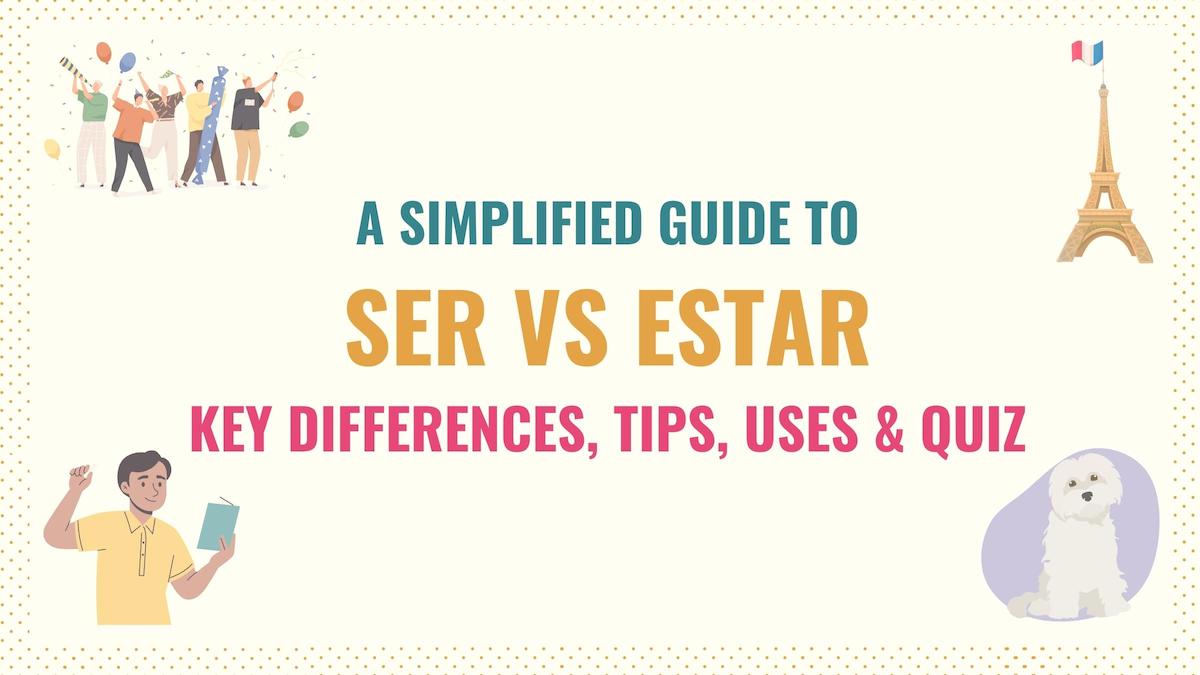As two of the most important verbs in Spanish, understanding the difference between ser and estar is crucial since they allow you to convey basic yet important information. So, the goal of this ser vs estar guide is to provide you with key simple patterns to identify each verb correctly.
- Overview of Ser and Estar: Uses
- When to Use Ser or Estar
- Bonus: Hay vs Ser vs Estar
- Key Points
- Practice Quiz: Ser vs Estar
- Dive Deeper: Next Steps to Learn Spanish
I can’t stress enough how indispensable these verbs are for daily conversations. So, I’ve included situations where ‘ser’ and ‘estar’ are often confused, simple explanations, common contexts where you need each verb, and a quiz to test your understanding.
Let’s do this!
Overview of Estar vs Ser: Common Uses
Ser and estar mean ‘to be’. However, they have distinct meanings and uses. In a simplified definition, ser is used to talk about lasting and inherent traits. On the other hand, estar refers to short or transitory conditions and states.
Check the difference between saying:
Yo soy mexicana.
I am Mexican.
Yo estoy en México y estoy enferma.
I am in Mexico and am sick.
Ser conveys what I am, a quality that is an essential part of my identity. But estar conveys where and how I am; these temporary situations can shift.
Here is a chart where you can see side by side the uses of ser and some examples:
| USE | SENTENCE |
|---|---|
| Identifying people or things | Él es Luis. He is Luis. |
| Material of something | La silla es de madera. The chair is made of wood. |
| Occupation | Sandy es doctora. Sandy is a doctor. |
| Origin & Nationality | Ustedes son de Alemania. You guys are from Germany. |
| Physical & Personality Traits | Tú eres muy amable. You are very kind. |
| Place of an event. | La fiesta es en mi casa. The party is at my house. |
| Possession & Relationships | Yo soy su hermana. I am her sister. |
| Time | El examen es en la tarde. The exam is in the afternoon. |
And over here, you can check the most common uses of estar:
| USE | SENTENCE |
|---|---|
| Actions in progress | Estoy comiendo. I am eating. |
| Conditions | Hoy está soleado. Today is sunny. |
| Emotions or states | Estamos ocupados. We are busy. |
| Location or position | Tú estás en España. You are in Spain. |
| Temporary occupation | July está de mesera. July is a waiter. |
In the sections below, we’ll explore some contexts where these verbs are easily confused, and you’ll learn when to use one or the other.
Take Note: Many teachers use the acronyms DOCTOR and PLACE to simplify the difference between estar and ser.
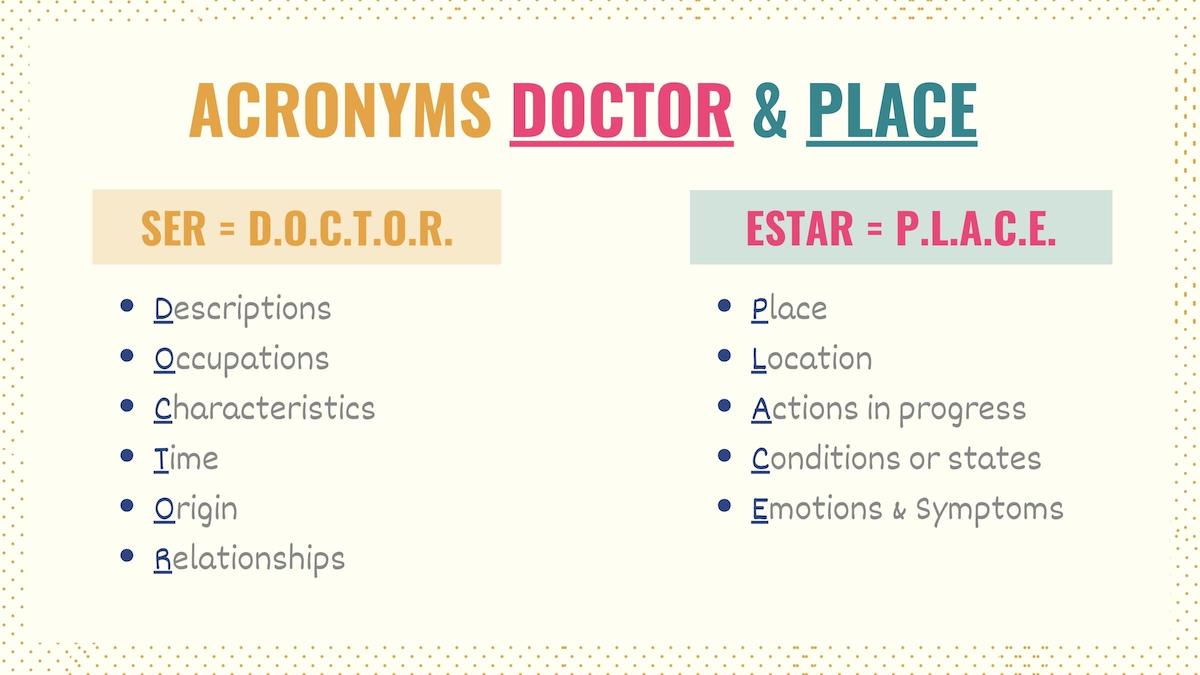
Examples of When to Use Ser vs Estar
Ser and estar have some distinct and specific uses that are clear and easy to identify, such as telling time and nationalities with ‘ser’, and talking about progressive actions with ‘estar’. However, there are certain situations where the line between these verbs seems thinner and can cause confusion.
So, let’s clear up these confusions, shall we?
This ain’t my first rodeo with the estar vs ser topic. And, over time, I found that the easiest way to summarize them is by identifying the questions they answer. So, here is my golden tip:
Estar responds to:
- Where are you?
- How are you? / How are you doing?
- What are you doing?
Ser responds to:
- Who are you?
- What are you?
- Where are you from?
- What time is it?
- When and where is…?
Keep in mind while many of these questions are posed to “you”, these questions apply to all people and things (subjects and objects).
In the sections below, we’ll explore in more detail the situations where ser and estar can be easily confused.
Ser or estar for location
In Spanish, we must use the verb estar to express where a person, place, or thing is located.
Sandra está en Madrid.
Sandra is in Madrid.
Yo estoy en mi cuarto.
I am in my room.
La torre Eiffel está en París.
The Eiffel tower is in Paris.
The location of places, even monuments or historical buildings, is always expressed with ‘estar’ because stores, houses, or venues can change their whereabouts or they can cease existing.
However, ser is used to say the location of an event. In other words, where something is going to happen.
La fiesta es en la casa de Jorge.
The party is at Jorge’s.
Su entrevista es en el segundo piso.
Your interview is on the second floor.
As a tip, when using ser to express the place of an event, you can also mention the time: Su entrevista es a las nueve, en el segundo piso.

Estar or ser for occupation
Mostly, the verb ‘ser’ is used to talk about a person’s profession or occupation. However, this is applied when the line of work is perceived as a professional, long-term job. In Spanish, we turn to estar de when talking about temporary occupations.
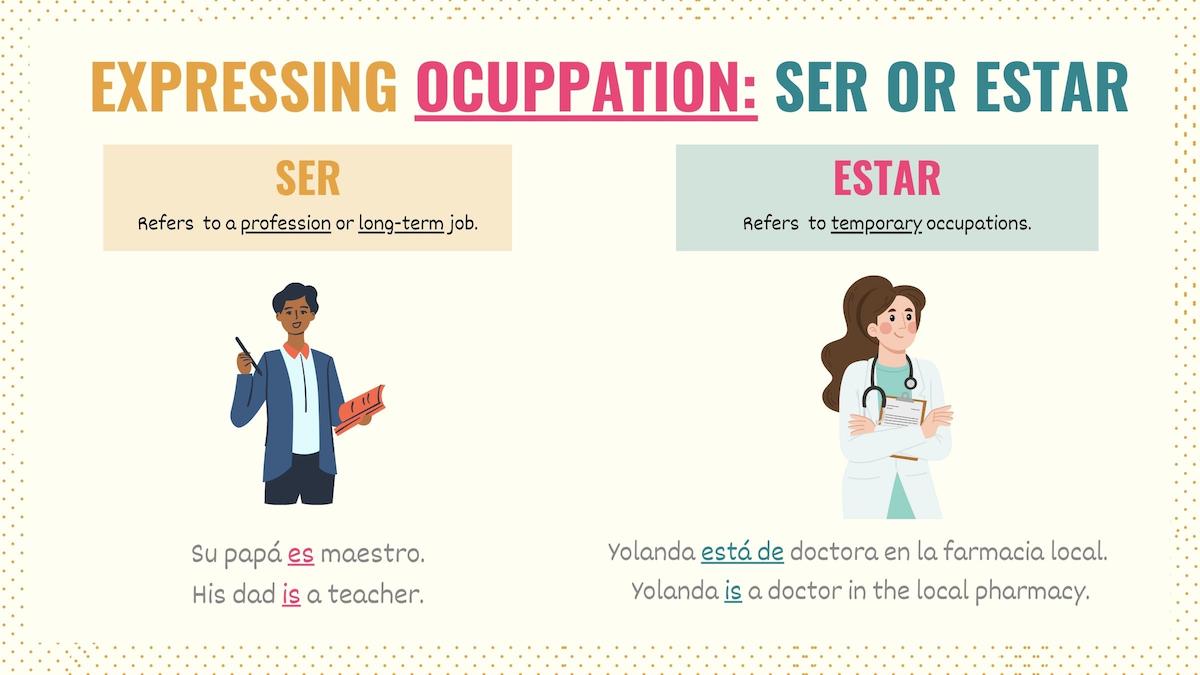
Here are some examples:
Su papá es maestro.
His dad is a teacher.
Mia y Tom son vendedores.
Mia and Tom are salespeople.
Por ahora, estoy de niñera.
I am a babysitter for the time being.
Yolanda está de doctora en la farmacia local.
Yolanda is a doctor in the local pharmacy.
In short, how people see a job determines whether they use estar or ser. So, based on the sentence, I know that Yolanda will not stay in that position forever.
Take Note: Notice that, unlike English, in Spanish, we don’t use indefinite articles (un, una) when expressing someone’s profession. It’s incorrect to say ‘su papá es un maestro’ unless you’re describing what type of teacher that person is.
Ser or estar for characteristics and descriptions
The context that leads to more confusion is when talking about characteristics and descriptions. Let’s take a closer look at this context.
In Spanish, we must use the verb ser to refer to inherent characteristics. Simply put, traits that make something or someone who or what they are (identity). This can range from physical and personality qualities to relationships, climate, etc.
For instance:
[Ser conjugated] + [adjective]
Marta es muy aburrida.
Marta is very boring.
México es muy caluroso y soleado.
Mexico is warm and sunny.
Eres muy guapo y amable.
You are very handsome and kind.
Adam y Paula son esposos.
Adam and Paula are husband and wife.
Because of its temporary nature, estar relates to descriptions with short-lived qualities, states, or conditions. In other words, emotions, marital status, physical or mental states, or symptoms.
Marta está aburrida.
Marta is bored.
Estoy muy cansada.
I am very tired.
Adam y Paula están casados.
Adam and Paula are married.
Hoy está soleado.
Today is sunny.
As a tip, the descriptions done with ‘estar’ are ‘right now’ descriptions. They communicate current states or conditions that can change.
Let’s analyze one example. When saying Marta es aburrida, I’m talking about her personality and who she is. But Marta está aburrida expresses how she’s currently feeling. Maybe she just can’t find something entertaining or exciting to do now. Once she does, this state will cease to exist.
Big difference, right?
Take Note: In Spanish, we say estar muerto (to be dead) instead of ser muerto. ‘Muerto’ is not an inherent quality but rather a state.
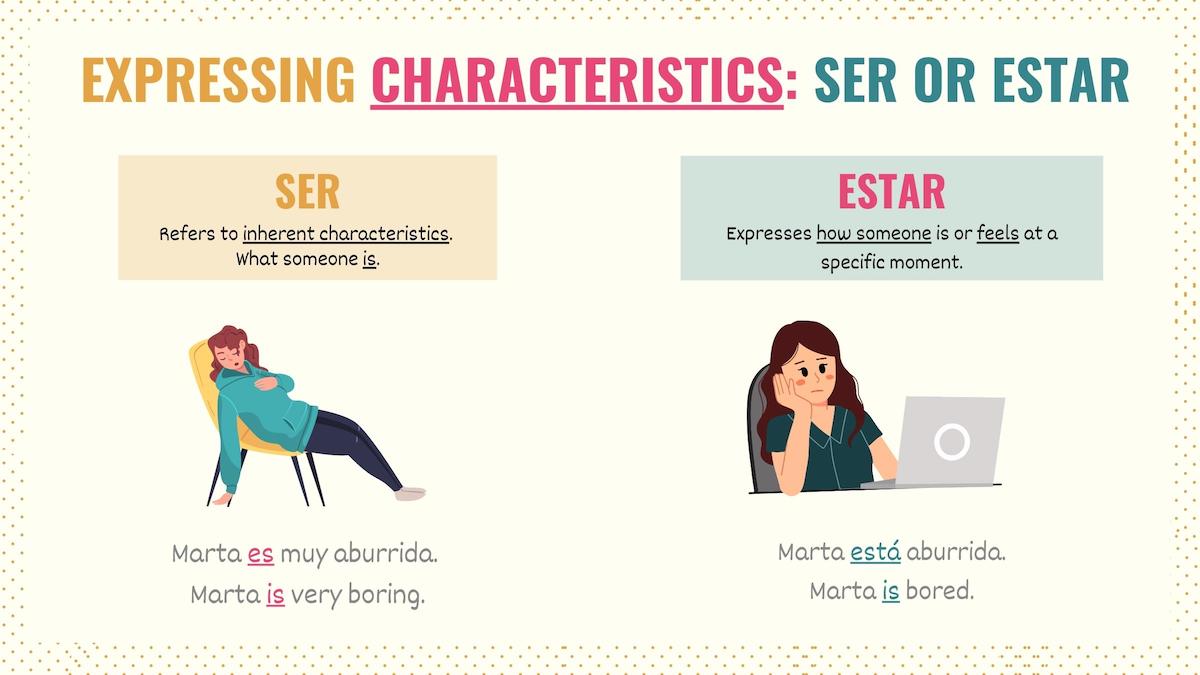
Adjectives that Changing Meaning with Ser & Estar
As you learned in the previous section, using ser or estar with certain Spanish adjectives conveys that a trait is innate or temporary. However, there are some adjectives you need to watch out for since using one verb or the other will change their meaning.
Examples of adjectives that change meaning with ser and estar are:
| ADJECTIVE | SER | ESTAR |
|---|---|---|
| Abierto | Be open-minded | Be open |
| Atento | Be attentive | To pay attention |
| Bueno | Be good | Be tasty / Be attractive |
| Callado | Be shy or reserved | Be silent |
| Cerrado | Be close-minded | Be closed |
| Delicado | Be fragile | Be delicate (health) |
| Despierto | Be smart | Be awake |
| Grave | Be serious | Be seriously ill |
| Interesado | Be opportunistic | Be interested |
| Malo | Be bad | Be sick |
| Listo | Be clever | Be ready |
| Orgulloso | Be proud | Be proud of |
| Rico | Be rich | Be tasty |
| Seco | Be dry (personality) | Be dry |
| Seguro | Be safe | Be sure |
| Verde | Be green | Be immature |
| Vivo | Be sharp | Be alive |
Here are some sentences for you to see the difference more clearly:
Sus papás son ricos.
Her parents are rich.
Estos dulces están ricos.
These candies are tasty.
Esa señora no es muy abierta.
That lady is not very open-minded.
La tienda siempre está abierta.
The store is always open.
Las toallas no están secas.
The towels are not dry.
Take Note: Adjective agreement is an essential rule you must keep in mind when using these words. Essentially, this means the adjective must match the gender and number of the noun it accompanies.
Ser vs Estar Conjugation Charts
On top of the different applications, ser and estar also have different conjugation rules. You can see their specific patterns in the conjugation chart below:

Bonus: Hay vs Ser vs Estar
In Spanish, hay, ser, and estar can be translated as ‘to be’. However, each one of these words has a different purpose in meaning.
Hay in Spanish is used to express the existence of something. Simply put, it lists what there is in a place. On the other hand, ser helps you identify people, tell time, talk about nationality or occupation, or refer to inherent qualities. Finally, estar expresses location or temporary conditions.
Check these sentences:
Hay un perro en el jardín.
There is a dog in the garden.
El perro es grande y blanco.
The dog is big and white.
Mi perro está en mi cuarto.
My dog is in my room.
Notice that, even though in example #1, it seems we’re talking about location, in reality, we’re just focusing on the presence of the dog.
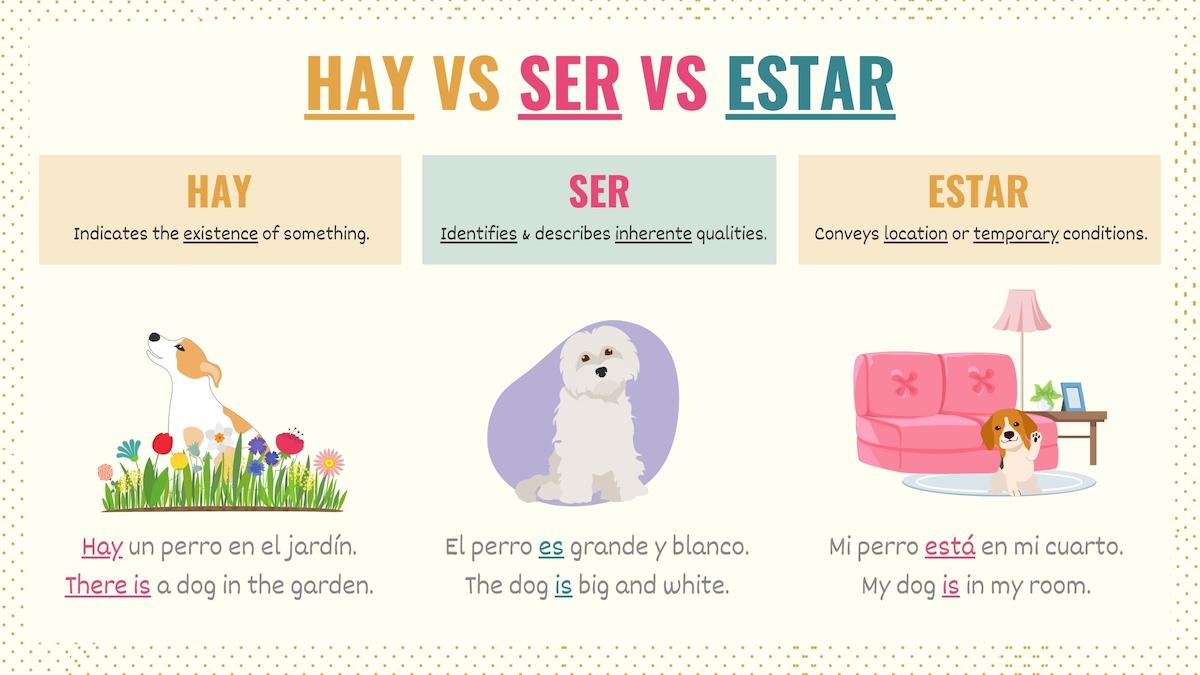
Difference Between Ser and Estar: Key Points
When it comes to tricky Spanish words, estar vs ser is one of the topics that causes a lot of confusion for learners. However, you must understand when and how to use them since they’re both essential verbs.
Here are some key points to remember:
- Both ser and estar mean ‘to be’, but have distinctive meanings and applications.
- In a nutshell, the difference between ser and estar is that the first refers to permanent or lasting traits, while the latter refers to temporary conditions.
- Ser is used to:
- Identify people or things
- Say the date and time
- Describe people or things
- Refer to the place of an event
- Express origin or nationality
- Talk about occupation
- On the other hand, the estar is used to:
- Talk about progressive actions
- Express location and position
- Describe conditions, emotions and states
- Refer to temporary occupations
- When referring to characteristics, ser refers to identity or traits that make a person or thing what they are. Estar expresses how something is at a particular moment.
- There are some adjectives whose meanings change depending on the verb you use.
- Ser responds to the questions:
- Who are you?
- What are you?
- Where are you from?
- What time is it?
- When and where is…?
- Meanwhile, estar answers:
- Where are you?
- How are you? / How are you doing?
- What are you doing?
- Neither ser or estar are used to say age.
In this graphic, you can see some situations where ser and estar seem to overlap, but depend on the specifics of either the context or use:
| Ser | Estar |
|---|---|
| Date Hoy es cinco de mayo. | Date (informal) Hoy estamos a cinco de mayo. |
| Occupation Tú eres abogado. | Occupation (temporary) Tú estás de mesero. |
| Personality & Physical traits. Joe es alto. | Conditions & States Joe está cansado. |
| Place of an event. La boda es en Toronto. | Location of things or people Estamos en Toronto. |
Ser vs Estar Practice Quiz
The best way to understand when to use ser and estar is by putting these verbs into practice. When you’re ready, click the button below to take our ser vs estar quiz and test your knowledge.
Estar vs Ser Additional Resources
Estar vs ser can be a challenging topic. To have a full understanding of these verbs, you may want to check more examples of when to use estar and the main uses of ser. Since these are irregular verbs, you should take some time to learn how to conjugate them. Here are some conjugation guides with these rules and conjugation quizzes so you can practice these verbs:
‘Ser’ and ‘estar’ work as auxiliary verbs in Spanish. We use estar with the progressive forms, which is a topic you should know as a beginner. On the other hand, ser allows you to form the passive voice in Spanish. You can review this topic later on your Spanish journey.
Download the Ser vs Estar in Spanish PDF
You’ve now learned when to use ser and estar in Spanish. This included multiple rules and approaches for understanding the questions they answer and the contexts and key uses. However, just memorizing these grammar and usage rules can be challenging. Confusing these verbs is a common challenge for beginners learning this language. Feel free to download my PDF for this guide with all the graphics, key points, rules, examples, and uses.

